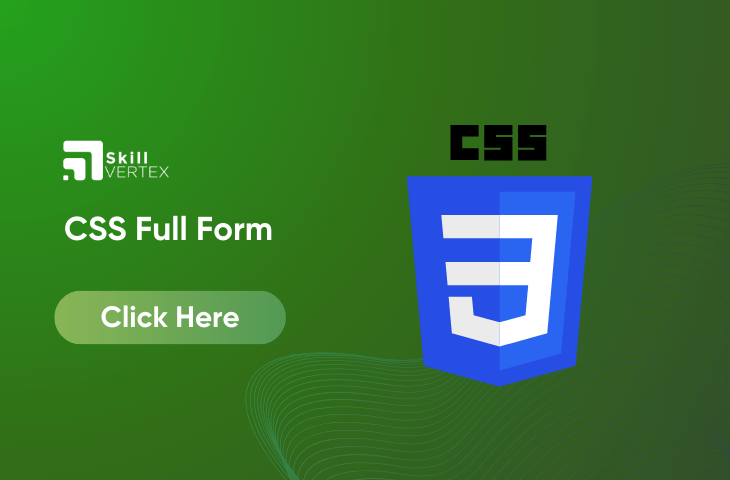Table of Contents
CSS Full Form
CSS stands for Cascading Style Sheet, it is a style sheet language used to shape the HTML elements that will be displayed in the browsers as a web page Elevating Web Design and User Experience. In the ever-evolving landscape of web development, few acronyms have wielded as much influence as CSS – Cascading Style Sheets.
CSS has transformed the way we perceive and interact with websites, playing a pivotal role in shaping the aesthetics and user experience of the digital realm. This article delves into the origin, significance, workings, and evolution of CSS, shedding light on how it has revolutionized web design.
CSS Full Form- Origins and Evolution
CSS emerged as a response to the growing complexity of web pages and the need for a standardized method to control their presentation. It was introduced in the late 1990s as a means to separate the content of a webpage from its appearance.
Before CSS, styling information was often embedded within HTML tags, leading to convoluted and challenging-to-maintain code. With CSS, designers gained the ability to define styles externally, paving the way for more organized and efficient web development.
CSS Full Form-The Concept of Cascading
The term “cascading” in CSS refers to the hierarchy of styles that can be applied to an HTML element. Multiple style sources can influence an element’s appearance – from inline styles within the HTML tag to styles in external CSS files.
If conflicts arise between these sources, the “cascading” nature of CSS dictates that the styles will be applied in a specific order of priority. This allows for a fine-tuned and flexible approach to designing and styling web content.
CSS Full Form – Styling and Design
CSS’s primary function is to control the visual presentation of HTML elements. Designers utilize CSS properties to define aspects such as colors, fonts, spacing, layout, and responsiveness. CSS empowers them to create visually appealing and consistent designs across different devices and screen sizes, contributing to a seamless user experience.
CSS Full Form – Separation of Concerns
One of the key principles behind CSS is the separation of concerns, which entails separating the structure (HTML) from the presentation (CSS) and functionality (JavaScript) of a web page. This separation enhances code maintainability, collaboration, and reusability. Styling changes can be made in the CSS file without altering the underlying content, promoting efficient development and updates.
CSS Full Form -Responsive Design
With the proliferation of mobile devices and varying screen sizes, responsive design has become imperative. CSS’s flexibility enables developers to design responsive layouts that adapt gracefully to different screens. Media queries, a CSS feature, allow styles to be applied based on factors like screen width, ensuring optimal user experiences on both desktop and mobile devices.
CSS Full Form – Frameworks and Preprocessors
The popularity of CSS has given rise to frameworks like Bootstrap and Foundation, which provide pre-built CSS components and styles. These frameworks expedite development by offering a standardized foundation that developers can build upon. Additionally, CSS preprocessors like SASS and LESS extend CSS’s capabilities by introducing variables, functions, and modularization, simplifying the process of writing and maintaining complex stylesheets.
CSS Full Form – Challenges and Evolution
While CSS has brought significant advancements to web design, it also presents challenges. Maintaining consistency across browsers can be a struggle due to browser-specific rendering issues. However, ongoing efforts within the web development community, along with modern browser standards, have mitigated many of these challenges.
CSS Full Form – Conclusion
Cascading Style Sheets (CSS) stands as an essential pillar of modern web development. Its ability to define visual elements, facilitate responsive design, and enforce separation of concerns has transformed how websites are created and experienced.
As the digital landscape continues to evolve, CSS remains at the forefront of design innovation, enabling developers to craft captivating, user-centric, and visually engaging web experiences that resonate across diverse audiences and devices.
The legacy of CSS is one of empowerment, as it empowers designers and developers alike to sculpt the aesthetics and interactivity of the online world.
FAQ- CSS Full Form
Q1. What are the 3 types of CSS?
Ans.Inline CSS.
Internal or Embedded CSS.
External CSS.
Q2. Why CSS is used?
Ans. CSS is used to define styles for your web pages, including the design, layout, and variations in display for different devices and screen sizes.
Q3.What is the syntax for CSS?
Ans. A CSS Syntax rule consists of a selector, property, and its value. The selector points to the HTML element where the CSS style is to be applied. The CSS property is separated by semicolons. It is a combination of the selector name followed by the property: value pair that is defined for the specific selector.
Hello, I’m Hridhya Manoj. I’m passionate about technology and its ever-evolving landscape. With a deep love for writing and a curious mind, I enjoy translating complex concepts into understandable, engaging content. Let’s explore the world of tech together

